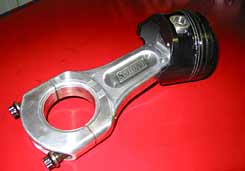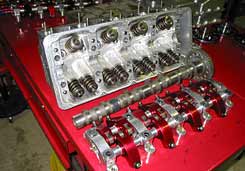| 
All five main caps have 4 cross bolts and 2
main studs and are made from 7075 alloy billets. The 4” stroke
crankshaft is made from EN26 material and is around 30% stronger
than an equivalent 4340 crank, however they take 120 odd
hours to machine and cost around $3,000 (Australian). The
crank features 3” mains and 2.4” big ends, and
obviously the large journal overlap also aids strength significantly.
Ross pistons fill the 4.44” bore and swing on super
tough Sainty billet rods, which are significantly beefier
than hemi fuel rods. A dry sump rounds out the short block.
 The
cylinder heads attach to the block with 18 evenly spaced
head studs, providing higher and more even clamping force.
On the first generation BTV a single 1.9” exhaust
valve and a pair of 1.6” inlet valves were used. Although
the total valve area using 2 1.6” inlet valves is equivalent
to a single 2.25” inlet, the total inlet valve circumference
is approximately 10” compared to 7” for a single
2.25” valve head – significantly increasing low-lift
flow and allowing the use of far less radical camshafts to
achieve the same flow. The second generation BTV features
significantly large 1.8” inlets and a 2” exhaust
valves coupled to larger square inlet ports and revised valvetrain
geometry to improve reliability. The
cylinder heads attach to the block with 18 evenly spaced
head studs, providing higher and more even clamping force.
On the first generation BTV a single 1.9” exhaust
valve and a pair of 1.6” inlet valves were used. Although
the total valve area using 2 1.6” inlet valves is equivalent
to a single 2.25” inlet, the total inlet valve circumference
is approximately 10” compared to 7” for a single
2.25” valve head – significantly increasing low-lift
flow and allowing the use of far less radical camshafts to
achieve the same flow. The second generation BTV features
significantly large 1.8” inlets and a 2” exhaust
valves coupled to larger square inlet ports and revised valvetrain
geometry to improve reliability.
 The valves are driven via
billet alloy rockers from a single overhead camshaft per
bank driven off the crank via an adjustable gear drive. A
pair of 14mm spark plugs neatly fit between the outer side
of the inlets and the exhaust with plenty of meat to prevent
torching – a typical problem in the cramped chamber
of a 4-valve nitro motor. The chamber itself is a modified
hemi configuration. The low valvetrain mass and general geometry
allows very low spring pressures, as little as 120 lb seat
pressure can control the valves at 10,000 rpm which is significantly
less than a hemi with its heavy valvetrain, long rocker geometry
and heavy large diameter valves. The valves are driven via
billet alloy rockers from a single overhead camshaft per
bank driven off the crank via an adjustable gear drive. A
pair of 14mm spark plugs neatly fit between the outer side
of the inlets and the exhaust with plenty of meat to prevent
torching – a typical problem in the cramped chamber
of a 4-valve nitro motor. The chamber itself is a modified
hemi configuration. The low valvetrain mass and general geometry
allows very low spring pressures, as little as 120 lb seat
pressure can control the valves at 10,000 rpm which is significantly
less than a hemi with its heavy valvetrain, long rocker geometry
and heavy large diameter valves.
 Not merely content to design and manufacture
their own engines, a whole host of further parts are theirs
as well. That includes the 88 GPM fuel pump, barrel valve,
mag drives, clutch, cannon, reverser, management for clutch
and fuel, 12” diff, dry sump system, and
even the chassis
are Sainty designed and built items along with hundreds of
other components, including almost every stud, nut, bolt
and washer in the entire car. Not merely content to design and manufacture
their own engines, a whole host of further parts are theirs
as well. That includes the 88 GPM fuel pump, barrel valve,
mag drives, clutch, cannon, reverser, management for clutch
and fuel, 12” diff, dry sump system, and
even the chassis
are Sainty designed and built items along with hundreds of
other components, including almost every stud, nut, bolt
and washer in the entire car.
So how well does it work, and what does it
cost to run, you may ask?
ADVERTISEMENT
 |
Keep in mind that nobody on the Sainty team
is what you would consider an experienced NHRA tour nitro
tuner, and they are definitely in uncharted territory as
far as getting help is concerned. The first generation Sainty
BTV ran into the 5.25 zone, though more typically they ran
in the mid to high 5’s. Many problems were found with
the first design such as a tendency to break rockers at just
the wrong moment. The Sainty team took advantage of a layoff
during a lack of racing in New South Wales and Victoria (the
Sainty Engineering shop is located in Sydney NSW) to revise
the design to produce the secnd generation BTV motor with
the aim of producing considerably more power and providing
a big step up in reliability.
|
